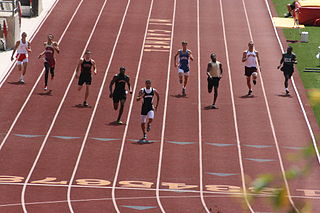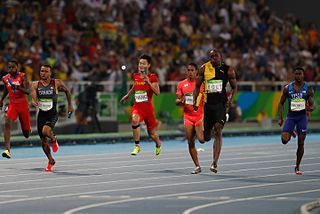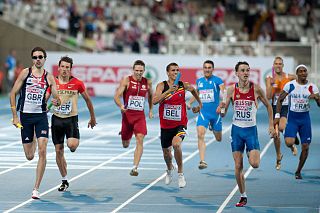| Location | La vămi, [1] Ocolişu Mic, Hunedoara, Romania |
|---|---|
| Coordinates | 45°42′32″N23°07′48″E / 45.709°N 23.130°E |
| Altitude | 480 m (1,575 ft) |
| Site notes | |
| Condition | Ruined |
It was a Dacian fortified town.
| Location | La vămi, [1] Ocolişu Mic, Hunedoara, Romania |
|---|---|
| Coordinates | 45°42′32″N23°07′48″E / 45.709°N 23.130°E |
| Altitude | 480 m (1,575 ft) |
| Site notes | |
| Condition | Ruined |
It was a Dacian fortified town.

The Royal Australian Navy (RAN) is the naval force of the Australian Defence Force (ADF). The professional head of the RAN is Chief of Navy (CN) Vice Admiral Mark Hammond AM, RAN. CN is also jointly responsible to the Minister of Defence (MINDEF) and the Chief of Defence Force (CDF). The Department of Defence as part of the Australian Public Service administers the ADF.

The 800 metres, or meters, is a common track running event. It is the shortest commonly run middle-distance running event. The 800 metres is run over two laps of an outdoor (400-metre) track and has been an Olympic event since the first modern games in 1896. During the winter track season the event is usually run by completing four laps of an indoor 200-metre track.

The 400 metres, or 400-meter dash, is a sprint event in track and field competitions. It has been featured in the athletics programme at the Summer Olympics since 1896 for men and since 1964 for women. On a standard outdoor running track, it is one lap around the track. Runners start in staggered positions and race in separate lanes for the entire course. In many countries, athletes previously competed in the 440-yard dash (402.336 m)—which is a quarter of a mile and was referred to as the 'quarter-mile'—instead of the 400 m (437.445 yards), though this distance is now obsolete.

A perennial candidate is a political candidate who frequently runs for elected office and rarely, if ever, wins. The existence of perennial candidates lies in the fact that in some countries, there are no laws that limit a number of times a person can run for office, or laws that impose a non-negligible financial penalty on registering to run for election.

The 100 metres, or 100-meter dash, is a sprint race in track and field competitions. The shortest common outdoor running distance, the 100-meter (109.36 yd) dash is one of the most popular and prestigious events in the sport of athletics. It has been contested at the Summer Olympics since 1896 for men and since 1928 for women. The inaugural World Championships were in 1983.

The 200 metres, or 200-meter dash, is a sprint running event. On an outdoor 400 metre racetrack, the race begins on the curve and ends on the home straight, so a combination of techniques is needed to successfully run the race. A slightly shorter race, called the stadion and run on a straight track, was the first recorded event at the ancient Olympic Games. The 200 m places more emphasis on speed endurance than shorter sprint distances as athletes predominantly rely on anaerobic energy system during the 200 m sprint. Similarly to other sprint distances, the 200 m begins from the starting blocks. When the sprinters adopt the 'set' position in the blocks they are able to adopt a more efficient starting posture and isometrically preload their muscles. This enables them to stride forwards more powerfully when the race begins and start faster.

The 4 × 100 metres relay or sprint relay is an athletics track event run in lanes over one lap of the track with four runners completing 100 metres each. The first runners must begin in the same stagger as for the individual 400 m race. Each runner carries a relay baton. Before 2018, the baton had to be passed within a 20 m changeover box, preceded by a 10-metre acceleration zone. With a rule change effective November 1, 2017, that zone was modified to include the acceleration zone as part of the passing zone, making the entire zone 30 metres in length. The outgoing runner cannot touch the baton until it has entered the zone, and the incoming runner cannot touch it after it has left the zone. The zone is usually marked in yellow, frequently using lines, triangles or chevrons. While the rule book specifies the exact positioning of the marks, the colours and style are only "recommended". While most legacy tracks will still have the older markings, the rule change still uses existing marks. Not all governing body jurisdictions have adopted the rule change.

The 4 × 400 metres relay or long relay is an athletics track event in which teams consist of four runners who each complete 400 metres or one lap. It is traditionally the final event of a track meet. At top class events, the first leg and the first bend of the second leg are run in lanes. Start lines are thus staggered over a greater distance than in an individual 400 metres race; the runners then typically move to the inside of the track. The slightly longer 4 × 440 yards relay, on an Imperial distance, was a formerly run British Commonwealth and American event, until metrication was completed in the 1970s.

The 110 metres hurdles, or 110-metre hurdles, is a hurdling track and field event for men. It is included in the athletics programme at the Summer Olympic Games. The female counterpart is the 100 metres hurdles. As part of a racing event, ten hurdles of 42 inches (106.7 cm) in height are evenly spaced along a straight course of 110 metres. They are positioned so that they will fall over if bumped into by the runner. Fallen hurdles do not carry a fixed time penalty for the runners, but they have a significant pull-over weight which slows down the run. Like the 100 metres sprint, the 110 metres hurdles begins in the starting blocks.

The 100 metres hurdles, or 100-meter hurdles, is a track and field event run mainly by women. For the race, ten hurdles of a height of 33 inches (83.8 cm) are placed along a straight course of 100 metres (109.36 yd). The first hurdle is placed after a run-up of 13 metres from the starting line. The next 9 hurdles are set at a distance of 8.5 metres from each other, and the home stretch from the last hurdle to the finish line is 10.5 metres long. The hurdles are set up so that they will fall over if bumped into by the runner, but weighted so this is disadvantageous. Fallen hurdles do not count against runners provided that they do not run into them on purpose. Like the 100 metres sprint, the 100 m hurdles begins with athletes in starting blocks.

The 2012 San Francisco Board of Supervisors elections occurred on November 6, 2012. Six of the eleven seats of the San Francisco Board of Supervisors were contested in this election. One incumbent was termed out of office, four ran for reelection, and one ran for initial election after being appointed to the seat.

Elections held in the state of Washington on November 6, 2012. A nonpartisan blanket primary was held on August 7, 2012.

The 2014 United States House of Representatives elections in Texas were held on Tuesday, November 4, 2014, to elect the 36 U.S. representatives from the state of Texas, one from each of the state's 36 congressional districts. The elections coincided with the elections of other federal and state offices, including a gubernatorial election and an election to the U.S. Senate.

Municipal elections were held in San Diego in 2012 for mayor, city attorney, five seats to the San Diego City Council, and propositions. The primary election was held on June 5, 2012, and the general election was held on November 6, 2012. This was the first city council election to use nine council districts. Two city council incumbents ran for reelection in their same district and one ran for election in the newly created ninth district.

The 2018 United States Senate elections were held on November 6, 2018. Among the 100 seats, the 33 of Class 1 were contested in regular elections while two others were contested in special elections due to Senate vacancies in Minnesota and Mississippi. The winners were elected to six-year terms running from January 3, 2019, to January 3, 2025. Senate Democrats had 26 seats up for election, while Senate Republicans had nine seats up for election.

The 2014 U.S. House of Representatives elections in Indiana was held on Tuesday, November 4, 2014 to elect 9 members of the U.S. House of Representatives from Indiana. The Members elected at this election will serve in the 114th Congress. Indiana has placed Republican and Democratic nominees on the ballot in a nation-best 189 consecutive U.S. House races across each of the last 19 election cycles since 1978.

The 2014 United States House of Representatives elections in Massachusetts were held on Tuesday, November 4, 2014 to elect the nine U.S. representatives from the Commonwealth of Massachusetts, one from each of the state's nine congressional districts. The elections coincided with the election of Massachusetts' Class II U.S. Senator and other elections to the United States Senate in other states and elections to the United States House of Representatives and various state and local elections, including the Governor of Massachusetts.

The 2014 United States House of Representatives elections in Missouri were held on Tuesday, November 4, 2014 to elect the eight U.S. representatives from the state of Missouri, one from each of the state's eight congressional districts.

The 2016 United States House of Representatives elections in Texas were held on November 8, 2016, to elect the 36 U.S. representatives from the state of Texas, one from each of the state's 36 congressional districts. The elections coincided with the 2016 presidential election, as well as other elections to the House of Representatives, elections to the United States Senate and various state and local elections. The primaries were held on March 1.

A general election was held in the U.S. state of Vermont on November 8, 2016. All of Vermont's executive officers were up for election as well as Vermont's Class III Senate seat and at-large seat in the United States House of Representatives. Primary elections were held on August 9, 2016.